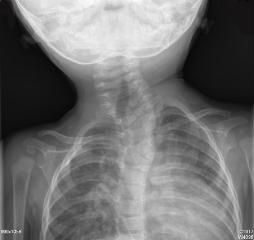Investigations
1st investigations to order
cervical spine x-ray
Test
Should be obtained routinely at initial visit to rule out vertebral anomalies.[Figure caption and citation for the preceding image starts]: Cervical spine x-ray showing numerous segmentation anomalies associated with a convex left cervico-thoracic scoliosis. This patient presented with a head tilt. There are segmentation anomalies in the lower thoracic and high cervical region. There is an acute convex left cervico-thoracic scoliosis with a hemi-vertebra at the apex of the curve. Butterfly vertebra is identified rostral to the hemi-vertebra, and segmentation anomalies are also identified caudal to the hemi-vertebraFrom the personal collection of Dr Joyce L. Oleszek; used with permission [Citation ends].
Result
negative in CMT
pelvic x-ray
Test
Should be obtained in children older than 6 months to rule out developmental dysplasia of the hip (DDH) if clinical examination reveals hip clicks, asymmetrical hip range of motion, or asymmetrical skin folds. In one study, the positive predictive value of clinical examinations for DDH was 52.6%.[23]
Diagnostic value of x-rays in children under 4 months is limited due to poor ossification of the femoral head.[24]
Result
negative in CMT
hip ultrasound
Test
Should be obtained in children under the age of 6 months if clinical examination reveals hip clicks, asymmetrical hip range of motion, or asymmetrical skin folds. In one study, the positive predictive value of clinical examinations for DDH was 52.6%.[23]
Result
negative in CMT
Investigations to consider
neck ultrasound
Test
Pathognomonic but not routinely done.
Result
sternocleidomastoid fibromatosis coli
skull x-ray
Test
Should be obtained if cranial asymmetry is not typical of that seen in CMT.
Result
negative in CMT
cervical/cranial MRI
Test
To rule out posterior fossa or spinal cord tumour.
Result
negative in CMT
Use of this content is subject to our disclaimer